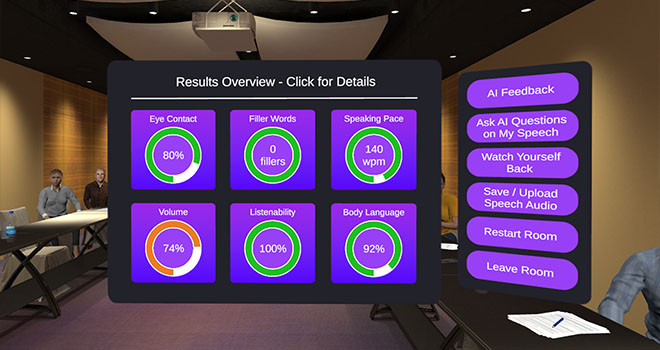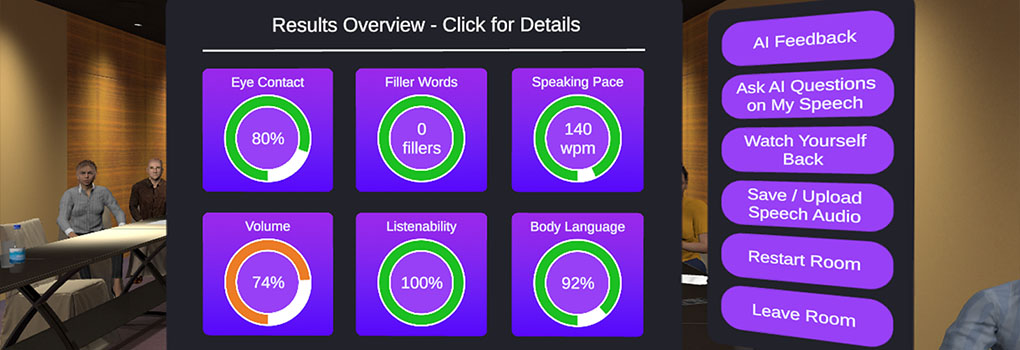Get AI Feedback on your Presentation with VR
Updated June 15, 2023 - Dom Barnard
Getting feedback on a speech can be difficult, and even harder to quantify your performance. In this article, we use the VirtualSpeech app to review a speech on a range of criteria, from eye contact to speaking pace.
The speech topic was how automotive companies could use VR to reduce prototyping costs. The actual topic is not important, as the speech analysis and feedback can be applied to any presentation for instant feedback.
Benefits of the VR app:
- Immerse the learner in realistic virtual rooms
- Provide AI-powered feedback on your speech or presentation
The first point is important as it goes some way to recreating the fear and excitement you might experience when presenting in front of a real audience. In virtual reality, we can simulate lighting distractions, mobile phones going off, audience members talking to each other, and a wide range of other situations which VR provides.

Speech evaluation from the app
The app gives AI-powered feedback on:
- Speaking pace
- Number of hesitation words
- Volume (loudness) of the learner's voice
- Eye contact performance
- Listenability (how easy the speech was to listen to)
- Body language feedback (self-evaluated)
For a full list of VR features, see the App Guide.
Feedback using speech-to-text technology
Technology background
Receiving feedback is essential for improving public speaking skills and ensuring that each time you practice, you're becoming a presenter. In order to do this, the app uses speech-to-text and other vocal technology to analyse the speech and provide feedback.
Once the app converts the speech to text, algorithms analyse this and provide meaningful and understandable results for the learner. This allows the learner to quantify their performance and improve areas of their speech each time.
Speech analysis - how did the learner perform?
In this example, the learner averages 106 words per minute, which is a little too slow – around 120 words per minute is preferable for a presentation.
The learner had 1 filler word, such as 'um' and 'ah', out of a total of 83 words. This is not bad, as filler words are not always a negative in a speech (particularly in a conversation).
In many cases, a pause from saying anything (i.e. silence) would be preferable to using filler words - this is something you can practice and work on.

Eye contact analysis
How eye contact is calculated
For eye contact analysis, the app assumes the eyes are looking directly forward from the head. In this way, when the learner moves their head to look at something, the app assumes the eyes move as the head moves. If you watch presentations, you'll notice this mostly holds true and is a fair assumption to make.
The app records the learners' eye contact throughout the speech and then provides a heatmap of where the learner was looking while speaking. This allows the learner to easily see any areas they have neglected or focussed too much on.
Eye contact analysis - how did the learner perform?
In our example, the learner performs well with eye contact, scoring 6/10. The audience is more likely to engage with the learner when speaking and understanding the message.
Saving and uploading the speech for detailed evaluation
Once learners have reviewed their performance, they have the option to save their speech and listen to it later, allowing them to identify areas that require improvement.
The learning portal provides a dedicated 'Results & Recordings' section where saved speeches can be accessed. This can be found both in the VR apps and through your web browser.
With the Enterprise package, you can also unlock an admin dashboard to track progress at scale and easily measure ROI. This will allow you to easily identify strengths and learning gaps.

Learners can save their audio recordings to the learning portal, which they can download and send to colleagues, friends, or even a trainer.
Track progress within the app
Progress from each practice session is stored, and can be viewed in VR or in the learning platform. With this, you can check how you are progressing over time.

In conclusion
The VirtualSpeech app provides a powerful way for people to analyse their speech or presentation. The feedback allows learners to identify weaker areas of their speech and work to improve those parts.
In addition, with the realistic environments, audience, and personalisation (load in your own slides), the app takes you close to being fully immersed in the environment.

